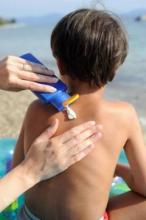Attitudes toward sun exposure – and behaviors – change between childhood and adolescence, researchers have found, suggesting that children in this age bracket may be critical targets for physicians to advise.
Among children who were interviewed at age 10 years and again at 13, those in the elder group were only half as consistent in their sunscreen use as they had previously been, and were significantly more likely to report liking the appearance of a tan or seeking to become tan. Actual incidence of sunburn and tanning, meanwhile, remained high and largely unchanged between ages 10 and 13 years, with recent sunburns reported by more than half of children at both ages.
The findings, published online Jan. 23 in Pediatrics, were the first to examine sunburn and sun behaviors prospectively in this age group.
Stephen W. Dusza, Dr.P.H., of Memorial Sloan-Kettering Cancer Center in New York, led SONIC (Study of Nevi in Children), which used self-reported data from 360 students who were enrolled as fifth graders in Framingham, Mass., schools in 2004 and had complete data upon follow-up in 2007. High-resolution photography of the back was conducted for all subjects at both points. Almost three-fourths (74%) of the subjects analyzed were white, and males accounted for more than half the sample (62%).
At baseline in 2004, 53% of subjects reported having had a sunburn (defined as "pink or red skin") at least once the previous summer, and this proportion remained similar (55%) at follow-up, a nonsignificant difference. Actual incidence of tanning also changed little. At both baseline and follow-up, about 85% of students reported having gotten a tan the previous summer (Pediatrics 2012;129:309-17).
Sunscreen use, meanwhile, dropped sharply. In 2004, 50% of students reported that they used sunscreen "often or always" when outside for 6 or more hours in the summer. By 2007, only 25% reported the same, a significant difference.
The children in the study with the highest risk of developing skin cancer – those with pale skin – experienced the sharpest increase in reported sunburns, Dr. Dusza and his colleagues found. In 2007, fair-skinned children were 40% more likely to report two or more recent sunburns than in 2004. By contrast, children with light olive to black skin were 70% less likely to report two or more recent burns at follow-up, compared with baseline.
Some 53% of students reported "liking a tan" at age 10, but 66% did by age 13, a significant difference. And although 22% of 10-year-olds reported deliberately spending time in the sun to get a tan, a full 40% did so at follow up, also a significant difference. Girls were twice as likely to report liking a tan in 2007, compared with 2004 (odds ratio, 2.4). Boys also were more likely to report liking a tan when they reached age 13 (OR, 1.5).
The researchers acknowledged as weaknesses their study’s reliance on self-reported sun behaviors by children, noting that these reports have been shown to have "fair to moderate agreement" with direct observation.
Moreover, they said, nearly one-fourth of the children recruited in 2004 dropped out of the study because of relocation, and could not be included in the analysis. Among these were a disproportionate number of children with darker skins, an understudied group as far as sun behaviors are concerned. And finally, because the study did not seek reasons for sunscreen use or nonuse, "it was beyond the scope of this study to ascribe reasons for the drop in sunscreen use during these 3 years."
Despite these limitations, the findings strongly underscore the necessity of "new and creative messages" in both schools and physicians’ offices, with an aim to promote consistent sunscreen use and to deter tanning in this important age bracket, Dr. Dusza and his colleagues wrote in their analysis. In the United States, melanoma is reported to be one of the two most common cancers of young people, so it is important to encourage strong sun protection practices at young ages, the researchers noted.
In addition, "further studies are required to learn how to interweave enhanced sun-protection policies in settings such as beaches, after-school sites, and sporting events frequented by preadolescents and adolescents," the researchers wrote. Particular effort is needed to reach this group, they added, because adolescence "is a period of flexing independence, coupled with feelings of invincibility."
It also is important because the use of tanning beds, particularly for girls, is reported to begin at age 14, Dr. Dusza and his colleagues said.


